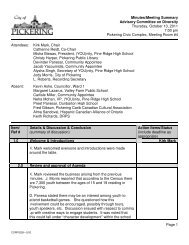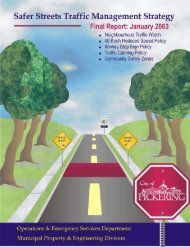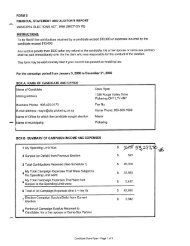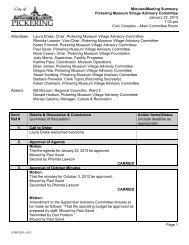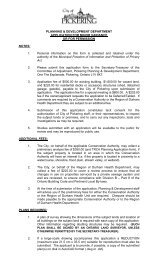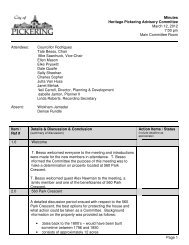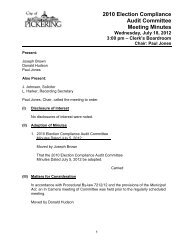Chapter A - Introduction - City of Pickering
Chapter A - Introduction - City of Pickering
Chapter A - Introduction - City of Pickering
You also want an ePaper? Increase the reach of your titles
YUMPU automatically turns print PDFs into web optimized ePapers that Google loves.
COMMENT MESPA RESPONSE (December 2011) CITY RESPONSE (October 2012) RESPONSE<br />
development (LID) measures to reduce the number <strong>of</strong> end-<strong>of</strong>-pipe facilities<br />
and minimize the run<strong>of</strong>f volume from development. A more thorough LID<br />
analysis including integration <strong>of</strong> the LID measures into the water management<br />
modelling would confirm that using LIDs will certainly not only reduce the<br />
number and size <strong>of</strong> end-<strong>of</strong>-pipe facilities, but also the type.<br />
groundwater recharge, etc. As a result, a<br />
comprehensive SWM/LID strategy is provided for<br />
Seaton. In addition and as discussed at the meeting<br />
and incorporated into the agreed-upon Table <strong>of</strong><br />
Contents for the NFSSRs, further analyses <strong>of</strong> LID<br />
measures and options will be undertaken in the<br />
NFSSRs.<br />
REPORT CHAPTER<br />
AND SECTION<br />
The use <strong>of</strong> dry ponds as well as co-locating dry facilities within park areas or<br />
playing fields as Brockridge Park is a more sustainable approach to<br />
stormwater management and result in dramatically lower future maintenance<br />
requirements and costs for the <strong>City</strong>. A current example <strong>of</strong> this can be seen in<br />
the <strong>City</strong>’s Brockridge Park at the Brock Road and Finch Avenue area.<br />
The potential use <strong>of</strong> dry ponds and co-locating SWMF<br />
within parks is noted in Section B6.2.<br />
Section B6.2<br />
Following a detailed review <strong>of</strong> the MESP, 42 <strong>of</strong> the 69 end-<strong>of</strong>-pipe facilities<br />
are discharging to intermittent streams. This is <strong>of</strong> great concern with respect<br />
to erosion and movement <strong>of</strong> the streams in the future, as they will ultimately<br />
become permanently flowing, with the application <strong>of</strong> the recommended<br />
erosion criteria (i.e. 25mm for 120 hours). Alternatively, run<strong>of</strong>f volume control<br />
through the implementation <strong>of</strong> LID’s may be required in these circumstances<br />
such that post-development run<strong>of</strong>f volumes are minimized.<br />
Development <strong>of</strong> a sustainable LID strategy with respect to full life cycle costs,<br />
including long term maintenance and operations, will be required at the<br />
NFSSR stage. The framework or outline for this LID strategy needs to be<br />
approved prior to submitting the NFSSR’s to the <strong>City</strong>.<br />
Headwater drainage feature water balance assessments<br />
have been complete that, along with the erosion<br />
assessments, address the issue <strong>of</strong> discharge <strong>of</strong> flows<br />
into intermittent drainage features. See Section B10.<br />
The MESPA addresses a framework for LID measures<br />
that is to be further assessed at the NFSSR stage. This<br />
requirement is noted in Section B2.3 and the Table <strong>of</strong><br />
Contents for the NFSSRs (Appendix J2).<br />
Section B10.0<br />
Section B10.0<br />
Section B2.3 and<br />
Appendix J2<br />
Stormwater Management Alternatives<br />
There seems to be an over reliance on end-<strong>of</strong>-pipe facilities from the outset to<br />
provide water quality, erosion control and flood control when other<br />
approaches are more environmentally sustainable and appropriate. The<br />
cumulative impact <strong>of</strong> these end-<strong>of</strong>-pipe stormwater management facilities<br />
could potentially increase channel erosion and deteriorate aquatic habitats<br />
within the associated watercourses, which is contrary to the principles and<br />
objectives <strong>of</strong> the CPDP. To <strong>of</strong>fset these impacts, there needs to be greater<br />
emphasis on considering “state-<strong>of</strong>-the-art” stormwater management<br />
approaches to manage run<strong>of</strong>f volumes and release rates rather than<br />
conventional stormwater management practices which only manage release<br />
rates. A more thorough discussion <strong>of</strong> stormwater management alternatives in<br />
the MESP Amendment is required in order to address the water management<br />
criteria and sustainability.<br />
An evaluation <strong>of</strong> alternatives and a comprehensive<br />
SWM/LID strategy have been prepared. Further,<br />
detailed modelling and analysis, presented in <strong>Chapter</strong> B<br />
Sections B5 through B9 identified storage and<br />
discharge design criteria, flood control requirements and<br />
erosion control resulting in the reduction <strong>of</strong> SWMFs to<br />
60. The modelling has confirmed that these end-<strong>of</strong>-pipe<br />
solutions are required.<br />
In addition and as discussed at various meetings with<br />
the agencies and incorporated into the agreed-upon<br />
Table <strong>of</strong> Contents for the NFSSRs, further analyses <strong>of</strong><br />
site specific alternatives and options will be undertaken<br />
in the NFSSRs.<br />
The <strong>City</strong> will accept the SWM/LID strategy that<br />
has been presented within the MESPA, so long<br />
as a funding solution can be found with respect<br />
to the operations and maintenance<br />
requirements <strong>of</strong> the recommended SWM/LID<br />
strategy.<br />
No action required. A funding solution has<br />
been found through the Fiscal Impact Study<br />
for operations and maintenance<br />
requirements for the SWM/LID strategy.<br />
Stormwater Management Plan and Facilities (NEW COMMENT)<br />
Having received <strong>Pickering</strong> Council endorsement, in December 2011, the <strong>City</strong><br />
released its “Stormwater Management Design Guidelines”, which outlines the<br />
design requirements for stormwater management facilities. It is the <strong>City</strong>’s<br />
expectation that the SLG will meet the objectives and design requirements as<br />
The MESPA references the <strong>City</strong>’s “Stormwater Management Design Guidelines” in <strong>Chapter</strong> B Section 6.0 and in <strong>Chapter</strong> J Section 2.0. Additionally, the<br />
<strong>City</strong> <strong>of</strong> <strong>Pickering</strong> OPA No. 22 is referenced in <strong>Chapter</strong> A. The <strong>City</strong> has agreed to conduct a consultation session to review the SMDG with the purpose <strong>of</strong><br />
ensuring that the Guidelines are considered appropriate for implementation in Seaton recognizing the significant level <strong>of</strong> environmental review and<br />
consultation that has been completed as part <strong>of</strong> the MESPA and the long term operation and maintenance analysis that was completed as part <strong>of</strong> the <strong>City</strong><br />
Fiscal Impact Study.<br />
<strong>Chapter</strong> A, Section<br />
A8.0; <strong>Chapter</strong> B,<br />
Section B6.0 and<br />
<strong>Chapter</strong> J, Section<br />
The Sernas Group Inc., Stonybrook Consulting Inc. December 2011, Revised February 2013 Master Environmental Servicing Plan - Amendment<br />
SPL Beatty, Bird and Hale Limited, Earthfx Inc. 07161 Seaton Community, <strong>City</strong> <strong>of</strong> <strong>Pickering</strong><br />
AMEC Earth & Environmental, R.J. Burnside Appendix A7 – Page 4<br />
Amos Environment + Planning



